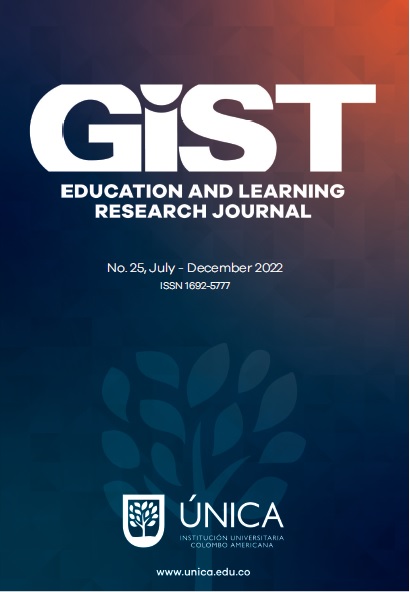A Creative Nonfiction Narrative Inquiry into an EFL Online Learning Community During the COVID-19 Pandemic
DOI:
https://doi.org/10.26817/16925777.1534Keywords:
Creative Nonfiction, Narrative Inquiry, Memory Archive, Coronavirus, EFL, E-meAbstract
University libraries globally launch coronavirus memory archival projects inviting the documentation of personal experience. Elicitations such as journal entries and oral history interviews fall under the category of life-writing. This Narrative Inquiry focuses on creative nonfiction stories produced by an online high school community and edited by the EFL teacher during the first full lockdown in Greece. The shift to distance education caused students to use ELF as a means of contrasting their local archival endeavors with global ones. The EFL teacher as researcher used mentor texts, collected the coronavirus stories on e-me online platform, engaged the online members in a peer-reviewing process and reauthored a collective narrative. Narrative writing analysis was employed to reflect the teacher’s initiative to commemorate a student community’s physical disconnectedness from onsite learning. The use of e-me for this collaborative venture offers practical implications for EFL practitioners such as going beyond the bounds of the traditional curriculum whilst identifying self-regulation as indication of resilience among students experiencing unprecedented circumstances.
Downloads
References
Bakhtin, M. M. (1981). The dialogic imagination: Four essays by M. M. Bakhtin. University of Texas Press.
Barkhuizen G., & Wette R. (2008). Narrative frames for investigating the experiences of language teachers. System, 36, 372-387. https://doi.org/10.1016/j.system.2008.02.002
Barkhuizen, G., Benson, P., & Chik, A. (2014). Narrative Inquiry in Language Teaching and Learning Research. Routledge. https://doi.org/10.4324/9780203124994
Barone, T., & Eisner, E. (1997). Arts-based educational research. In R. M. Jaeger (Ed.), Complementary methods for research in education (2nd ed.), (pp. 75-116). American Educational Research Association.
Barratt Hacking, E., Blackmore, C., Bullock, K., Bunnell, T., Donnelly, M., & Martin S. (2016). The International Mindedness Journey: School Practices for developing and assessing International Mindedness across the IB Continuum. https://www.ibo.org/globalassets/publications/ib-research/continuum/international-mindedness-final-report-2017-en.pdf.
Bennett, M. J. (Ed.). (2015). The Sage Encyclopedia of Intercultural Competence. SAGE Publications, Inc. https://doi.org/10.4135/9781483346267
Buchanan, R. J. (2020). What COVID-19 is teaching me about writing. Writing Teacher Education in Extraordinary Times, 9(1), 1-5.
Burroway, J. (2003). Writing fiction: A guide to narrative craft (6th ed.). Longman.
Caulley, D. N. (2008). Making qualitative research reports less boring: The techniques of writing Creative Nonfiction. Qualitative Inquiry, 14(3), 424-449. https://doi.org/10.1177/1077800407311961
Clandinin, D. J., & Connelly, F. M. (2000). Narrative Inquiry: Experience and story in qualitative research. Jossey-Bass.
Connelly, F. M., & Clandinin, D. J. (2006). Narrative inquiry. In J. L. Green, G. Camilli, & P. Elmore (Eds.). Handbook of complementary methods in education research (3rd ed.), (pp. 477-487). Lawrence Erlbaum.
Creswell, J. W. (2015). Planning, Conducting, and EvaIuating Quantitative and QuaIitative Research (5th ed.). Pearson.
Doman, E. (2015). Intercultural Communication as revealed in Language Learning Histories. The Journal of Intercultural Communication, 38. http://www.immi.se/intercultural/nr38/doman.html.
Engle, J. (2020, 20 March). How is the coronavirus outbreak affecting your life? How are you staying connected and sane in a time of social distancing? The New York Times. https://www.nytimes.com/2020/03/20/learning/how-is-the-coronavirus-outbreak-affecting-your-life.html.
Gamlen, P. (2020, March 18). Social Distancing: What story could this image tell? The New York Times. https://www.nytimes.com/2020/03/18/learning/social-distancing.html.
Gerard, P. (2018). Creative Nonfiction: Researching and crafting stories of real life (2nd ed.). Waveland Press, Inc.
Gutkind, L. (2000). Why I chose the creative nonfiction way of life. Fourth Genre: Explorations in Nonfiction, 2(1), 200-206. https://doi.org/10.1353/fge.2000.0000
Josselson, R. (2004). The hermeneutics of faith and the hermeneutics of suspicion. Narrative Inquiry, 14(1), 1-28. https://doi.org/10.1075/ni.14.1.01jos
Kennette, L., & Chapman, M. (2021). Providing positive student feedback in an online environment. Academia Letters, 1-3. https://doi.org/10.20935/AL203
Kim, J. (2016). Understanding Narrative Inquiry: The crafting and analysis of stories as research. SAGE Publications, Inc. https://doi.org/10.4135/9781071802861
Land, A. (2021, January 21). Gone astray. Malmö University. https://student.mau.se/en/calendar/Students-reflect-on-Corona-in-writing-and-photography/#accordion-73726
Liu, Y., & Xu, Y. (2011). Inclusion or exclusion? A Narrative Inquiry of a language teacher's identity experience in the 'New Work Order' of Competing Pedagogies. Teaching and Teacher Education, 27(3), 589-597. https://doi.org/10.1016/j.tate.2010.10.013
Lott, B. (2000). Toward a definition of Creative Nonfiction. Fourth Genre: Explorations in Nonfiction, 2(1), 192-200. https://doi.org/10.1353/fge.2013.0450
Malmö University (Producer). (2020). Creative Writing I-HT20-EN212A-02303. https://utbildningsinfo.mau.se/kurs/en212a/start/20202-02303/kursplan/20202
Megalou, E., Koutoumanos, A., Tsilivigos, Y., & Kaklamanis, C. (2015). Introducing "e-me," the Hellenic digital educational platform for pupils and teachers. Proceedings of EDULEARN15: Education and New Learning Technologies 7th annual International Conference (pp. 1-10). Barcelona, Spain. https://www.researchgate.net/publication/280095364_Introducing_e-me_the_Hellenic_Digital_Educational_Platform_for_Pupils_and_Teachers.
O'Sullivan, H. (2010). Autonomy abroad: Metaphors of Mündigkeit in Language Learner Narrative. Language and Intercultural Communication, 10(2), 106-108. https://doi.org/10.1080/14708470903348515
Patwell, B. (2021). Reflecting on leading meaningful change through COVID. Academia Letters, 1-7. https://doi.org/10.20935/AL480
Polkinghorne, D. E. (1988). Narrative knowing and the human sciences. State University of New York Press.
Polkinghorne, D. E. (1995). Narrative configuration in qualitative analysis. Qualitative Studies in Education, 8(1), 5-23. https://doi.org/10.1080/0951839950080103
Robinson, J. A., & Hawpe, L. (1986). Narrative thinking as a heuristic process. In T. R. Sarbin (Ed.). Narrative Psychology: The storied nature of human conduct, (pp. 111-125). Praeger.
Sameshima, P. (2007). Seeing shadows in new light: A Procatalepsis on Narrative Inquiry as professional development. New Horizons in Education, 55, 10-21.
Schulten, K. (2019, September 4). Mentor texts. The New York Times. https://www.nytimes.com/2019/09/04/learning/mentor-text-reflecting-on-anexperience.html.
Silverberg, M. (2019). Relief: Observations on Creative Nonfiction as Pedagogy. LEARNing Landscapes, 2, 249-258. https://doi.org/10.36510/learnland.v12i1.991
Spence, D. P. (1986). Narrative smoothing and clinical wisdom. In T. R. Sarbin (ed.), Narrative Psychology: The storied nature of human conduct (pp. 211-232). Praeger.
Ypsilanti, A. (2020, May 2). A change in morning habits. University of Oxford. https://oclw.web.ox.ac.uk/article/a-change-in-morning-habits
Downloads
Published
How to Cite
Issue
Section
License
Copyright (c) 2022 GIST – Education and Learning Research Journal

This work is licensed under a Creative Commons Attribution-NonCommercial-NoDerivatives 4.0 International License.
| Article metrics | |
|---|---|
| Abstract views | |
| Galley vies | |
| PDF Views | |
| HTML views | |
| Other views | |








